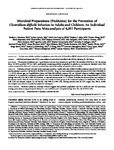Microbial Preparations (Probiotics) for the Prevention of Clostridium difficile Infection in Adults and Children: An Individual Patient Data Meta-analysis of 6,851 Participants.
| dc.contributor.author | Johnston, BC | |
| dc.contributor.author | Lytvyn, L | |
| dc.contributor.author | Lo, CK-F | |
| dc.contributor.author | Allen, SJ | |
| dc.contributor.author | Wang, D | |
| dc.contributor.author | Szajewska, H | |
| dc.contributor.author | Miller, M | |
| dc.contributor.author | Ehrhardt, S | |
| dc.contributor.author | Sampalis, J | |
| dc.contributor.author | Duman, DG | |
| dc.contributor.author | Pozzoni, P | |
| dc.contributor.author | Colli, A | |
| dc.contributor.author | Lönnermark, E | |
| dc.contributor.author | Selinger, CP | |
| dc.contributor.author | Wong, S | |
| dc.contributor.author | Plummer, S | |
| dc.contributor.author | Hickson, Mary | |
| dc.contributor.author | Pancheva, R | |
| dc.contributor.author | Hirsch, S | |
| dc.contributor.author | Klarin, B | |
| dc.contributor.author | Goldenberg, JZ | |
| dc.contributor.author | Wang, L | |
| dc.contributor.author | Mbuagbauw, L | |
| dc.contributor.author | Foster, G | |
| dc.contributor.author | Maw, A | |
| dc.contributor.author | Sadeghirad, B | |
| dc.contributor.author | Thabane, L | |
| dc.contributor.author | Mertz, D | |
| dc.date.accessioned | 2018-07-20T11:09:04Z | |
| dc.date.issued | 2018-07 | |
| dc.identifier.issn | 0899-823X | |
| dc.identifier.issn | 1559-6834 | |
| dc.identifier.uri | http://hdl.handle.net/10026.1/11863 | |
| dc.description.abstract |
OBJECTIVETo determine whether probiotic prophylaxes reduce the odds of Clostridium difficile infection (CDI) in adults and children.DESIGNIndividual participant data (IPD) meta-analysis of randomized controlled trials (RCTs), adjusting for risk factors.METHODSWe searched 6 databases and 11 grey literature sources from inception to April 2016. We identified 32 RCTs (n=8,713); among them, 18 RCTs provided IPD (n=6,851 participants) comparing probiotic prophylaxis to placebo or no treatment (standard care). One reviewer prepared the IPD, and 2 reviewers extracted data, rated study quality, and graded evidence quality.RESULTSProbiotics reduced CDI odds in the unadjusted model (n=6,645; odds ratio [OR] 0.37; 95% confidence interval [CI], 0.25-0.55) and the adjusted model (n=5,074; OR, 0.35; 95% CI, 0.23-0.55). Using 2 or more antibiotics increased the odds of CDI (OR, 2.20; 95% CI, 1.11-4.37), whereas age, sex, hospitalization status, and high-risk antibiotic exposure did not. Adjusted subgroup analyses suggested that, compared to no probiotics, multispecies probiotics were more beneficial than single-species probiotics, as was using probiotics in clinical settings where the CDI risk is ≥5%. Of 18 studies, 14 reported adverse events. In 11 of these 14 studies, the adverse events were retained in the adjusted model. Odds for serious adverse events were similar for both groups in the unadjusted analyses (n=4,990; OR, 1.06; 95% CI, 0.89-1.26) and adjusted analyses (n=4,718; OR, 1.06; 95% CI, 0.89-1.28). Missing outcome data for CDI ranged from 0% to 25.8%. Our analyses were robust to a sensitivity analysis for missingness.CONCLUSIONSModerate quality (ie, certainty) evidence suggests that probiotic prophylaxis may be a useful and safe CDI prevention strategy, particularly among participants taking 2 or more antibiotics and in hospital settings where the risk of CDI is ≥5%.TRIAL REGISTRATIONPROSPERO 2015 identifier: CRD42015015701Infect Control Hosp Epidemiol 2018;771-781. | |
| dc.format.extent | 771-781 | |
| dc.format.medium | Print-Electronic | |
| dc.language | en | |
| dc.language.iso | en | |
| dc.publisher | Cambridge University Press (CUP) | |
| dc.subject | Adolescent | |
| dc.subject | Adult | |
| dc.subject | Aged | |
| dc.subject | Anti-Bacterial Agents | |
| dc.subject | Child | |
| dc.subject | Child, Preschool | |
| dc.subject | Clostridium Infections | |
| dc.subject | Cross Infection | |
| dc.subject | Female | |
| dc.subject | Humans | |
| dc.subject | Infant | |
| dc.subject | Male | |
| dc.subject | Middle Aged | |
| dc.subject | Probiotics | |
| dc.subject | Randomized Controlled Trials as Topic | |
| dc.subject | Risk Factors | |
| dc.subject | Young Adult | |
| dc.title | Microbial Preparations (Probiotics) for the Prevention of Clostridium difficile Infection in Adults and Children: An Individual Patient Data Meta-analysis of 6,851 Participants. | |
| dc.type | journal-article | |
| dc.type | Journal Article | |
| dc.type | Meta-Analysis | |
| plymouth.author-url | https://www.ncbi.nlm.nih.gov/pubmed/29695312 | |
| plymouth.issue | 7 | |
| plymouth.volume | 39 | |
| plymouth.publication-status | Published | |
| plymouth.journal | Infect Control Hosp Epidemiol | |
| dc.identifier.doi | 10.1017/ice.2018.84 | |
| plymouth.organisational-group | /Plymouth | |
| plymouth.organisational-group | /Plymouth/Faculty of Health | |
| plymouth.organisational-group | /Plymouth/Faculty of Health/School of Health Professions | |
| plymouth.organisational-group | /Plymouth/REF 2021 Researchers by UoA | |
| plymouth.organisational-group | /Plymouth/REF 2021 Researchers by UoA/UoA03 Allied Health Professions, Dentistry, Nursing and Pharmacy | |
| plymouth.organisational-group | /Plymouth/Research Groups | |
| plymouth.organisational-group | /Plymouth/Research Groups/Institute of Health and Community | |
| plymouth.organisational-group | /Plymouth/Research Groups/Plymouth Institute of Health and Care Research (PIHR) | |
| plymouth.organisational-group | /Plymouth/Users by role | |
| plymouth.organisational-group | /Plymouth/Users by role/Academics | |
| dc.publisher.place | United States | |
| dcterms.dateAccepted | 2018-03-13 | |
| dc.rights.embargodate | 2019-4-26 | |
| dc.identifier.eissn | 1559-6834 | |
| dc.rights.embargoperiod | 12 months | |
| rioxxterms.versionofrecord | 10.1017/ice.2018.84 | |
| rioxxterms.licenseref.uri | http://www.rioxx.net/licenses/under-embargo-all-rights-reserved | |
| rioxxterms.licenseref.startdate | 2018-07 | |
| rioxxterms.type | Journal Article/Review |


